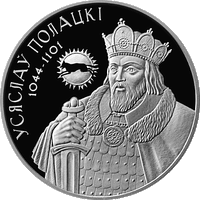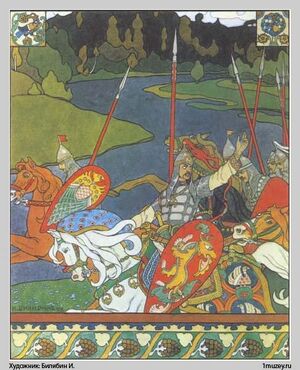Vseslav Bryachislavich of Polotsk, Grand Prince of Kiev, Prince of Polotsk, was born circa 1039 in Polotsk, Polatsk Rayon, Vitsebsk Voblasts, Belarus to Bryachislav Izyaslavich of Polotsk (c997-1044) and NN of Vitebsk and died 24 April 1101 Polotsk, Polatsk Rayon, Vitsebsk Voblasts, Belarus of unspecified causes.
Vseslav Bryachislavich of Polotsk (c. 1039 – 1101), also known as Vseslav the Sorcerer or Vseslav the Seer, was the most famous ruler of Polotsk and was briefly Grand Prince of Kiev in 1068–1069. Together with Rostislav Vladimirovich| and voivode Vyshata made up a coalition against the Yaroslaviches triumvirate. Polotsk's Cathedral of Saint Sophia (completed in 1066) is one of the most enduring monuments on the lands of modern Belarus and dates to his 57-year reign.

The reverse of a 20 ruble Belarusian silver commemorative coin issued in 2005 with Vseslav ("Usiaslau") of Polotsk and a depiction of him as a werewolf in the background.
His Life
Vselav was the son of Bryachislav Izyaslavich, Prince of Polotsk and Vitebsk, and was thus the great-grandson of Vladimir I of Kiev and Rogneda of Polotsk. He was born in ca. 1030–1039 in Polotsk (with Vasili as his baptismal name) and married around 1060.
He took the throne of Polotsk in 1044 upon his father's death, and although he was the senior member of the Rurik Dynasty for his generation, since his father had not been prince in Kiev, Vseslav was excluded (izgoi) from the grand princely succession. In fact, since he was the only major prince in Rus' not descended from Yaroslav, he was, according to Simon Franklin and Jonathan Shepard, "an outsider from within" [1]
Unable to secure the capital, which was held by Yaroslav's three sons, Vseslav started pillaging the northern areas of Kievan Rus'. In 1065, he laid siege to Pskov but was thrown back. In the winter of 1066-1067, he pillaged and burnt Novgorod the Great, removing the bell and other religious objects from the Cathedral of Holy Wisdom and bringing them to decorate his own cathedral of the same name in Polotsk.[2] His attack threatened to cut the sons of Yaroslav in the Middle Dnieper region off from Scandinavia, the Baltic region, and the far north, important sources of men, trade, and income (in furs for example) for the Rus' princes in the Middle Dnieper. The attack also forced the young Mstislav, then enthroned in Novgorod, to flee back to his father, Izyaslav, in Kiev, and was thus and affront to the Grand Prince of Kiev. The Yaroslavichi joined forces and marched north, sacking Minsk (then under the control of Polotsk) and defeating Vseslav in battle on the Nemiga River on March 3, 1067 [3] Vseslav fled but was treacherously captured during the peace talks in June, when Izyaslav violated his oath.[4] He was then imprisoned in Kiev.
As Grand Prince of Kiev
During the Kiev Uprising of 1068, brought about by defeat at the hands of the Kipchaks in the Battle of thr Alta River and Izyaslav's unwillingness to arm the veche so its members could march out and face the nomads a second time, the crowd freed Vseslav from prison, and proclaimed him Grand Prince of Kiev, forcing Izyaslav to flee to Poland. Returning with an army seven months later, Izyaslav retook his throne, and Vseslav fled back to Polotsk.[5] After several years of complicated struggle with Izyaslav, he finally secured Polotsk in 1071. During the last 30 years of his reign, his chief enemies were Vsevolod Yaroslavich and his son Vladimir Monomakh.
Vseslav died April 24, 1101, the Wednesday before Good Friday according to the Russian Primary Chronicle—indeed the chronicles strangely link the two events, as if the sorcerer had died as a result of the crucifixion and resurrection. He was buried in the Saint Sophia Cathedral in Polotsk.[6]
His Family
Vseslav had six sons:
- Davyd Vseslavich, Prince of Polotsk,
- Roman Vseslavich, Prince of ? (probably of Drutsk). Roman perished either in Ryazan or Murom. His widow became a nun and lived in Polotsk, Saint Sophia Cathedral where she opened her charity. They had no children.
- Gleb Vseslavich, Prince of Minsk;
- Rogvolod Vseslavich, Prince of Drutsk;
- Svyatoslav Vseslavich, Prince of Vitebsk;
- Rostislav Vsesalvich (?-?). He presumably was the Prince of Lukoml and later in 1129 sent by Vladimir II Monomakh to Byzantium with the rest of Vseslaviches. Who was his wife is uncertain as well as his descendants.
- There are some discussion whether Vseslav had six or rather seven sons. Some historians (L.Alekseev and V.Tatishchev) believe that Boris is baptized name of Rogvolod and both of them one and the same person.
St. Euphrosyne of Polotsk is sometimes said to be his daughter, although her date of birth is given as 1120, two decades after Vseslav's death and thus she could not be his child; other sources, however, say she is the daughter of Svyatoslav Vseslavich, and thus the granddaughter of Vseslav. She founded a number of monasteries in Polotsk and the surrounding region and is considered one of the patron saints of Belarus.
Vseslav in Literature and Legend
Vseslav in the Chronicles
Vseslav had a great reputation for sorcery. The Russian Primary Chronicle states that he was conceived by sorcery and was born with a caul (the remains of the placenta) on his head, and that the sorcerers told his mother that this should be bound to his head for the rest of his life as it was a sign of good luck.[7] In modern Belarusian he is known as Usiasłaŭ the Sorcerer; in Russian he is Vselav Charadei or Vseslav Veshchii, Vseslav the Sorcerer or Vseslav the Seer.

Volga Sviatoslavich, alias Volkh Vseslavich, the bogatyr based on Vseslav of Polotsk; a drawing by the Russian artist Ivan Bilibin.
Vseslav in "The Tale of Igor's Campaign"
Vseslav also appears in the 12th-century epic The Tale of Igor's Campaign, where, as in several byliny or folk-tales, he is depicted as a werewolf. In The Igor Tale, his defeat at the Nemiga River is shown to illustrate that inter-princely strife is weaking the Russian land. Vseslav is also said to be able to hear the church bells (stolen from Novgorod) of his cathedral at Polotsk all the way from Kiev:
"In the seventh age of Troyán Vséslav cast his lots for the Maiden dear to him."
"He with wiles at the last tore himself free: and galloped to the city of Kíev; with his weapon took hold of the golden throne of Kíev; galloped from them like a wild beast at midnight from Bĕ́lgorod, swathed himself in a blue mist, rent asunder his bonds into three parts, opened wide the gates of Nóvgorod, shattered the Glory of Yarosláv [the First]; galloped like a wolf from Dudútki to the Nemíga."
"On the Nemíga the sheaves are laid out with heads; men thresh with flails in hedgerows; on the barn-floor they spread out life; they winnow the soul from the body."
"On the blood-stained Nemíga the banks were sown with bane,—sown with the bones of the sons of Russia."
"Prince Vséslav was a judge to his subjects, he appointed cities for the princes: but he himself at night raced like a wolf from Kiev to the Idol [or, (accepting the reading of the text unaltered)—to the Lord] of Tmutarakáń, raced, like a wolf across the path of the great Khors."
"To him at Polotsk they rang the bells early for matins at Saint Sophia; and he at Kíev heard the sound."[8]
Volkh Vseslavich/Volga Svyatoslavich and Vseslav of Polotsk
Vseslav may also be the basis for the bogatyr or Volga Svyatoslavich or (Volkh Vseslavyevich), who is found in a cycle of byliny. Volkhvs were priests of the pre-Christian Ruthenian religion and were thought to possess magical powers. This fact may be tied to Vseslav's alleged magical as well as his lupine aspects. In the Ruthenian Christianity volkhv is said to have been the son of a serpent and the Princess Marfa Vseslavevna and could transform himself into a wolf and other animals.[9] That, of course, sounds as a fairy tale, however Christianity as a religion while still being challenged by people that followed the older traditions used this misinterpretation to outcast the followers of Slavic paganism. Volkhvs of Novgorod were well known to challenge the well established Christianity in Kiev in the 11th century, which resulted in Vseslav's victory when Mstislav Izyaslavovich[ fled to Kiev. Not long after that the same volkhvs were calling to uprising against Gleb Svyatoslavovich. Volkh appears in a number of drawings by the late-nineteenth and early 20th-century Russian artist Ivan Bilibin, who was heavily influenced by Russian folklore.
See also
- List of Russian rulers
- List of Ukrainian rulers
References
Children
| Name | Birth | Death | Joined with |
| Davyd Vseslavich of Polotsk (c1052-c1129) | 1052 | 1129 Byzantium, Byzantine Empire | Nomen nescio |
| Roman Vseslavich of Drutsk (c1054-c1115) | 1054 | 1115 Murom, Murom Rayon, Vladimir Oblast, Russia | |
| Gleb Vseslavich of Minsk (c1055-1119) | 1055 | 13 September 1119 Kiev, Ukraine | Anastasia Yaropolkovna (c1070-1159) |
| Rogvolod Vseslavich of Polotsk (c1057-1128) | 1057 | 1128 Polotsk | |
| Svyatoslav Vseslavich of Vitebsk (c1065-c1130) | 1065 | 1130 Constantinople, Turkey | Sofiya Vladimirovna (c1078-c1140) |
| Rostislav Vseslavich of Lukoml (1070-c1135) | 1070 | 1135 | |
Siblings
| Name | Birth | Death | Joined with |
| Vseslav Bryachislavich of Polotsk (c1039-1101) | 1039 Polotsk, Polatsk Rayon, Vitsebsk Voblasts, Belarus | 24 April 1101 Polotsk, Polatsk Rayon, Vitsebsk Voblasts, Belarus | |
Residences
Footnotes (including sources)
Vseslav Bryachislavich of Polotsk Rurikovich Born: 1039 Died: 1101
| ||
| Preceded by Bryachislav Izyaslavich |
Prince of Polotsk 1044–1101 |
Succeeded by Mstislav Izyaslavich |
| Preceded by Izyaslav I |
Grand Prince of Kiev 1068–1069 |
Succeeded by Izyaslav I |
| Preceded by Svyatopolk Izyaslavich |
Prince of Polotsk 1071–1101 |
Succeeded by Davyd Vseslavich |
|}
References
- ^ Simon Franklin and Jonathan Shepard, The Emergence of Rus 750-1200 (London and New York: Longman, 1996), 251.
- ^ Lavrentevskaia Letopis (PSRL I), 166; Ipatevskaia Letopis (PSRL 2), 155; A. N. Nasonov, Novgorodskaia Pervaia Letopis: Starshego i mladshego izvodov (Moscow and Leningrad: ANSSR, 1950), 17, 186; Novgorodskaia Tretaia Letopis (PSRL 3), 212; Novgorodskaia chetvertaia letopis (PSRL 4), 123
- ^ Franklin and Shepard, The Emergence of Rus, 252.
- ^ Lavrentevskaia Letopis (PSRL 1), 166–7; Franklin and Shepard, The Emergence of Rus, 252.
- ^ Lavrentevskaia letopis (PSRL 1), 171–2.
- ^ The Novgorodian First Chronicle as well as the Lavrentian and Hypatian Chronicles mention his death but not the place of burial. NPL, 17, 202; Lavrentevskaia Letopis (PSRL 1), 275; Ipatevskaia Letopis (PSRL 2), 250.
- ^ Lavrentevskaia Letopis (PSRL 1), 155.
- ^ Leonard Magus, "Tale of the Armament of Igor", Part II, Sacred Texts.com
- ^ Roman Jakobson and Marc Szeftel, "The Vseslav Epos," in Roman Jakobson and Ernest J. Simmons, eds., Russian Epic Studies. Memoirs of the American Folklore Society 42 (Philadelphia: American Folklore Society, 1949, p. 83; available online at Volkh Vseslav'evich Bylina: A Poem of Vseslav the Sorcerer. Jack V. Haney, The Complete Russian Folktale (Armonk, NY: M. E. Sharpe, 1999), 7; Dianne E. Farrell, "Shamanic Elements in Some Early Eighteenth Century Russian Woodcuts," Slavic Review 52, No. 4 (Winter 1993): 725–744; Felix J. Oinas, "The Problem of the Aristocratic Origin of Russian Byliny," Slavic Review Vol. 30, No. 3 (Sept. 1971): 513–522.
| Persondata | |
|---|---|
| NAME | Vseslav Of Polotsk |
| ALTERNATIVE NAMES | |
| SHORT DESCRIPTION | |
| DATE OF BIRTH | |
| PLACE OF BIRTH | Polotsk |
| DATE OF DEATH | April 24, 1101 |
| PLACE OF DEATH | Polotsk |
Warning: Default sort key "Vseslav Of Polotsk" overrides earlier default sort key "Rurik, Vseslav Bryachislavich".